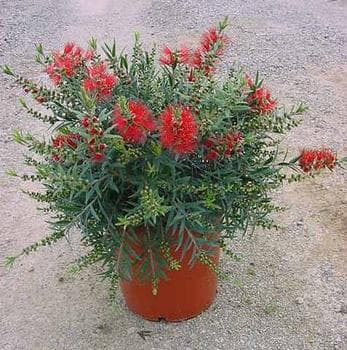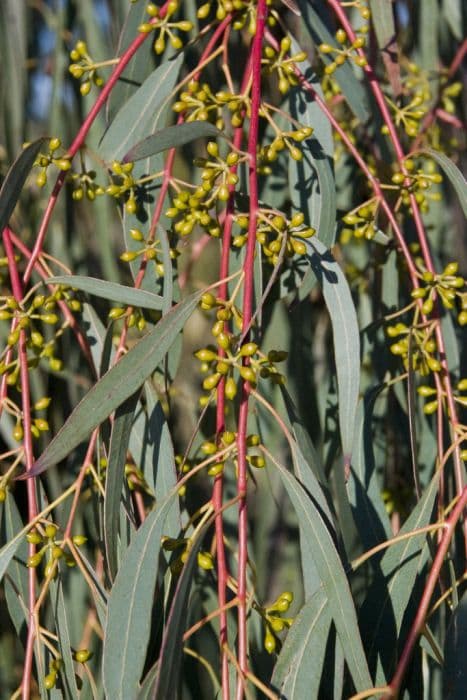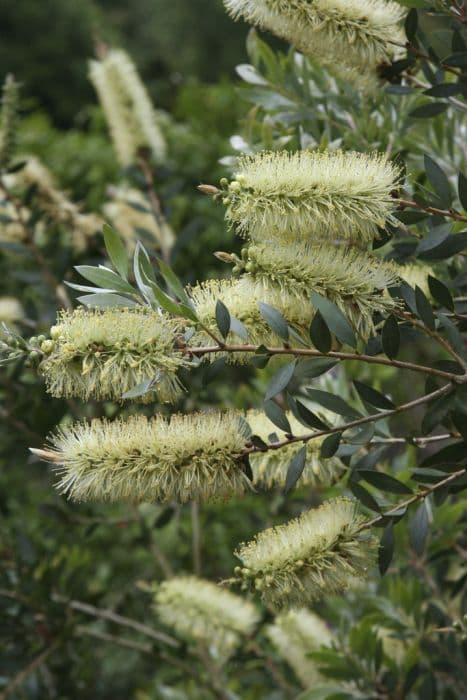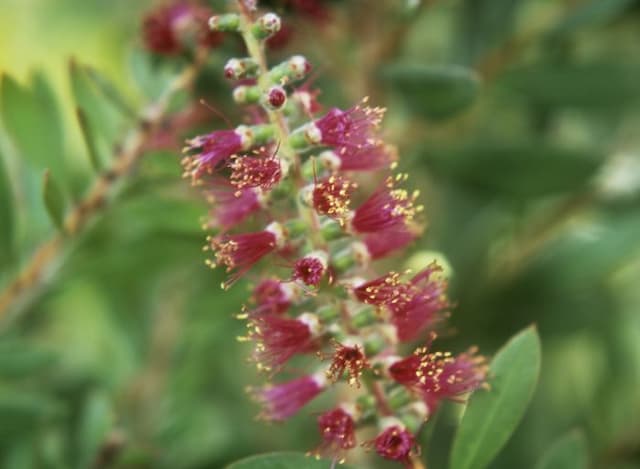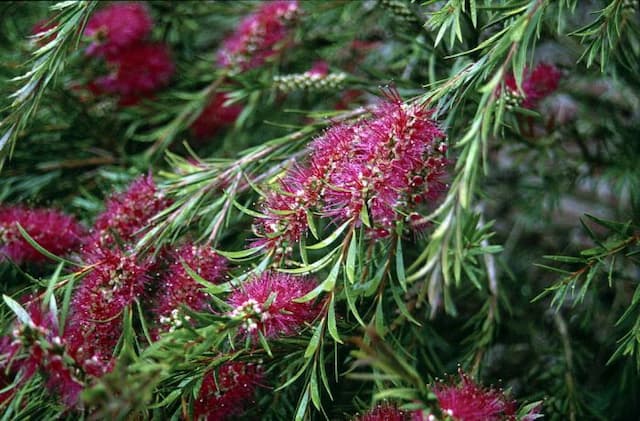Jounama Snow Gum Eucalyptus pauciflora subsp. debeuzevillei

ABOUT
The plant known commonly as Jounama Snow Gum is an evergreen tree characterized by its striking appearance. It features smooth bark that peels away in ribbons to reveal patches of white, gray, and occasionally green or yellowish hues beneath, creating a mottled and often shiny appearance. During colder months, the bark can take on a reddish coloration around the edges of the peeling sections, adding to its visual interest. The leaves of the Jounama Snow Gum are waxy and blue-green, with a lanceolate shape – a long and narrow form tapering to a point. They grow densely on the branches, sometimes exhibiting a slightly curved aspect. Young foliage often starts out as a more round or heart shape with a softer, gray-green color before maturing into the typical adult foliage. The flowers of this tree are typically white and may occur in clusters or individually. They have a fluffy, fringed look due to the many stamens that encircle the small cream or white-colored centers, giving the blooms a decorative, pompom-like appearance. The tree also produces woody, cone-like fruit that starts out as a green hue and matures to a brownish color. These fruits can hold onto the branches for extended periods before releasing their seeds. Overall, the Jounama Snow Gum is notable for its striking bark and attractive foliage, which make it an appealing tree for its ornamental value. Its capacity to thrive in cold conditions is evident in its adaptability and the features that help it survive in challenging climates.
About this plant
 Names
NamesSynonyms
Jounama Snow Gum, Debeuzeville's Snow Gum, Weeping Gum, White Sallee
Common names
Eucalyptus pauciflora var. debeuzevillei Maiden, Eucalyptus debeuzevillei (Maiden) Maiden.
 Toxicity
ToxicityTo humans
The Snow Gum is generally not considered highly toxic to humans. However, like many eucalyptus species, various parts of the plant, especially the leaves, contain essential oils such as eucalyptol which can be toxic when ingested in large quantities. Ingesting the leaves might lead to symptoms including gastrointestinal upset, nausea, vomiting, and diarrhea. Eucalyptus oil, if consumed, can potentially lead to more serious symptoms including central nervous system depression or even coma.
To pets
The Snow Gum can be toxic to pets, particularly dogs, cats, and horses. The leaves contain essential oils and compounds such as eucalyptol, which can cause symptoms if eaten. In pets, symptoms of eucalyptus poisoning may include drooling, vomiting, diarrhea, depression, and weakness. Severe cases could lead to seizures and even coma. It's advisable to keep pets away from this plant to prevent the possibility of ingestion and the associated risks.
 Characteristics
CharacteristicsLife cycle
Perennials
Foliage type
Evergreen
Color of leaves
Varies
Flower color
White
Height
12-50 feet (3.6-15 meters)
Spread
12-15 feet (3.6-4.5 meters)
Plant type
Tree
Hardiness zones
7
Native area
Australia
Benefits
 General Benefits
General Benefits- Ornamental value: Eucalyptus pauciflora subsp. debeuzevillei, commonly known as the Jounama Snow Gum, provides aesthetic appeal with its attractive bark, which peels off in strips to reveal a smooth, cream, grey or green surface underneath.
- Drought resistance: This subspecies has a high tolerance to dry conditions, making it suitable for landscapes that experience water scarcity.
- Cold tolerance: It is known for its ability to withstand cold temperatures, even frosts and snow, which is unusual for a eucalyptus, making it valuable for cooler climate gardens.
- Wildlife habitat: The Jounama Snow Gum offers habitat and food for various species of birds and insects, playing a role in supporting local biodiversity.
- Windbreak: Its dense foliage and sturdy nature can serve as a protective barrier against strong winds when planted as part of a windbreak or shelterbelt.
- Erosion control: The extensive root system helps to stabilize soil and control erosion, especially in areas prone to heavy rains or slopes.
 Medical Properties
Medical PropertiesThis plant is not used for medical purposes.
 Air-purifying Qualities
Air-purifying QualitiesThis plant is not specifically known for air purifying qualities.
 Other Uses
Other Uses- Jounama Snow Gum is used in bonsai cultivation, where its attractive bark and foliage make it a popular choice for those practicing the art of miniature tree shaping.
- The wood of Jounama Snow Gum can be used in woodworking and craft due to its beautiful grain and color, suitable for small decorative objects.
- Jounama Snow Gum's branches and leaves are sometimes used in floral arrangements, particularly in Australia, to add a unique texture and scent.
- The tree's bark can be used in tanning to impart a tan color to leather, taking advantage of the tannins present in the bark.
- The leaves of Jounama Snow Gum produce a natural dye, which can be used in textile arts for dyeing fabrics in shades ranging from yellow to brown.
- Because of its ability to withstand cold temperatures, Jounama Snow Gum is planted as a windbreak in high-altitude gardens or landscapes.
- The fibrous bark of this tree can be used in crafting, such as making cordage or as a component in papermaking.
- Its striking appearance during winter, when leaves may drop, makes Jounama Snow Gum a favored subject for photography and painting, especially in snowscapes.
- Jounama Snow Gum can be used as a natural insect repellent, with leaves burnt to deter insects due to the eucalyptus oils they contain.
- This tree can also serve as a habitat and food source for wildlife, such as birds and insects, providing ecological benefits beyond human use.
Interesting Facts
 Feng Shui
Feng ShuiThe Jounama Snow Gum is not used in Feng Shui practice.
 Zodiac Sign Compitability
Zodiac Sign CompitabilityThe Jounama Snow Gum is not used in astrology practice.
 Plant Symbolism
Plant Symbolism- Resilience: The Eucalyptus pauciflora subsp. debeuzevillei, commonly known as Snow Gum, can withstand severe cold and snow conditions, symbolizing the ability to endure challenging times and environments.
- Healing: Eucalyptus is widely known for its medicinal properties, particularly its leaves, which produce an essential oil used to relieve respiratory congestion and to alleviate cold symptoms, representing healing and recovery.
- Cleansing: Snow Gum has a cleaning effect both spiritually and environmentally because its leaves are often used in herbal remedies as well as for purifying the air, representing purification and renewal.
- Protection: Due to its hardy nature, the Snow Gum is seen as a guardian or protector, able to survive in hostile conditions, symbolizing safeguarding and shelter.
 Water
WaterThe Snow Gum requires watering during its growing season which typically runs from spring through to autumn. During these months, water the plant when the top inch of the soil feels dry, which may be once a week, depending on the weather and soil drainage. Generally, it may need around 1-2 gallons for a young tree and more as it matures and depending on the size of the tree. It's crucial to avoid overwatering, as the Snow Gum does not like to sit in wet soil. During winter, reduce watering significantly and only water if there is no rainfall and the ground is dry.
 Light
LightThe Snow Gum prefers full sun to partial shade, thriving best with a minimum of six hours of direct sunlight daily. Ideally, the plant should be situated in a spot where it can receive unfiltered sunlight for most of the day. Spots that are too shaded should be avoided as it can inhibit the growth and overall health of the tree.
 Temperature
TemperatureThe Snow Gum is cold-hardy and can tolerate temperatures as low as -20°F, making it suitable for USDA zones 7 through 8. It can survive short-term temperature spikes above its ideal range but prefers a cooler climate with summer temperatures not exceeding 80°F. The ideal temperature for this eucalyptus species would be between 30°F during winter nights to 75°F through the summer days.
 Pruning
PruningThe Snow Gum may be pruned for shaping and removing any damaged or diseased limbs. Pruning is best done in late winter or early spring before new growth begins. It generally doesn't require much trimming; however, annual inspection and the removal of problematic branches will help maintain tree health. Ensure clean cuts and use proper pruning tools.
 Cleaning
CleaningAs needed
 Soil
SoilThe Jounama Snow Gum prefers a well-draining soil mix with a slightly acidic to neutral pH of 6.0-7.0. A good recipe for this eucalyptus would be one part native garden soil, one part peat or coconut coir, and two parts perlite or coarse sand to ensure adequate drainage.
 Repotting
RepottingJounama Snow Gum trees are fast-growers and should be repotted every 2-3 years when young to accommodate their growing root system. As they mature, repotting frequency can decrease to every 3-5 years.
 Humidity & Misting
Humidity & MistingJounama Snow Gum thrives in moderate to low humidity conditions. It is well-adapted to outdoor environments where the humidity level mirrors that of its native Australian alpine regions, which can be on the drier side.
 Suitable locations
Suitable locationsIndoor
Place in bright, indirect light and ensure air flow.
Outdoor
Plant in full sun, shelter from harsh winds.
Hardiness zone
7-10 USDA
 Life cycle
Life cycleThe life cycle of Eucalyptus pauciflora subsp. debeuzevillei, commonly known as 'Jounama Snow Gum', starts with seed germination, where the plant begins as a seedling emerging from seed dispersed by wind or wildlife. The seedling then develops into a juvenile phase, characterized by rapid growth and the presence of rounder juvenile foliage. As it matures, 'Jounama Snow Gum' enters the adult vegetative stage marked by the growth of lance-shaped adult leaves, a more extensive root system, and a sturdier trunk. The reproductive phase follows, with the tree producing white flowers that attract pollinators and subsequently form woody capsules containing numerous seeds. After seed dispersal, the cycle may begin again, while the parent plant may remain productive for many years, potentially flowering and seeding annually. The mature tree can also resprout from epicormic buds or from the lignotuber if damaged by environmental factors such as fire, which is a common occurrence in its natural habitat.
 Propogation
PropogationPropogation time
Spring to Summer
Eucalyptus pauciflora subsp. debeuzevillei, commonly known as the Snow Gum, is ideally propagated through seed. The best time to sow Snow Gum seeds is during the warmth of late winter to early spring when temperatures remain around 68 degrees Fahrenheit (20 degrees Celsius). To propagate, the tiny seeds should be scattered onto the surface of a well-draining seed raising mix and gently pressed into the substrate; they should not be covered with soil as they require light for germination. Consistent moisture is crucial, but the soil should never become waterlogged. Germination usually takes place within 2 to 4 weeks with appropriate warmth and humidity. Seedlings can be transplanted to individual containers once they are large enough to handle and after the risk of frost has passed.
